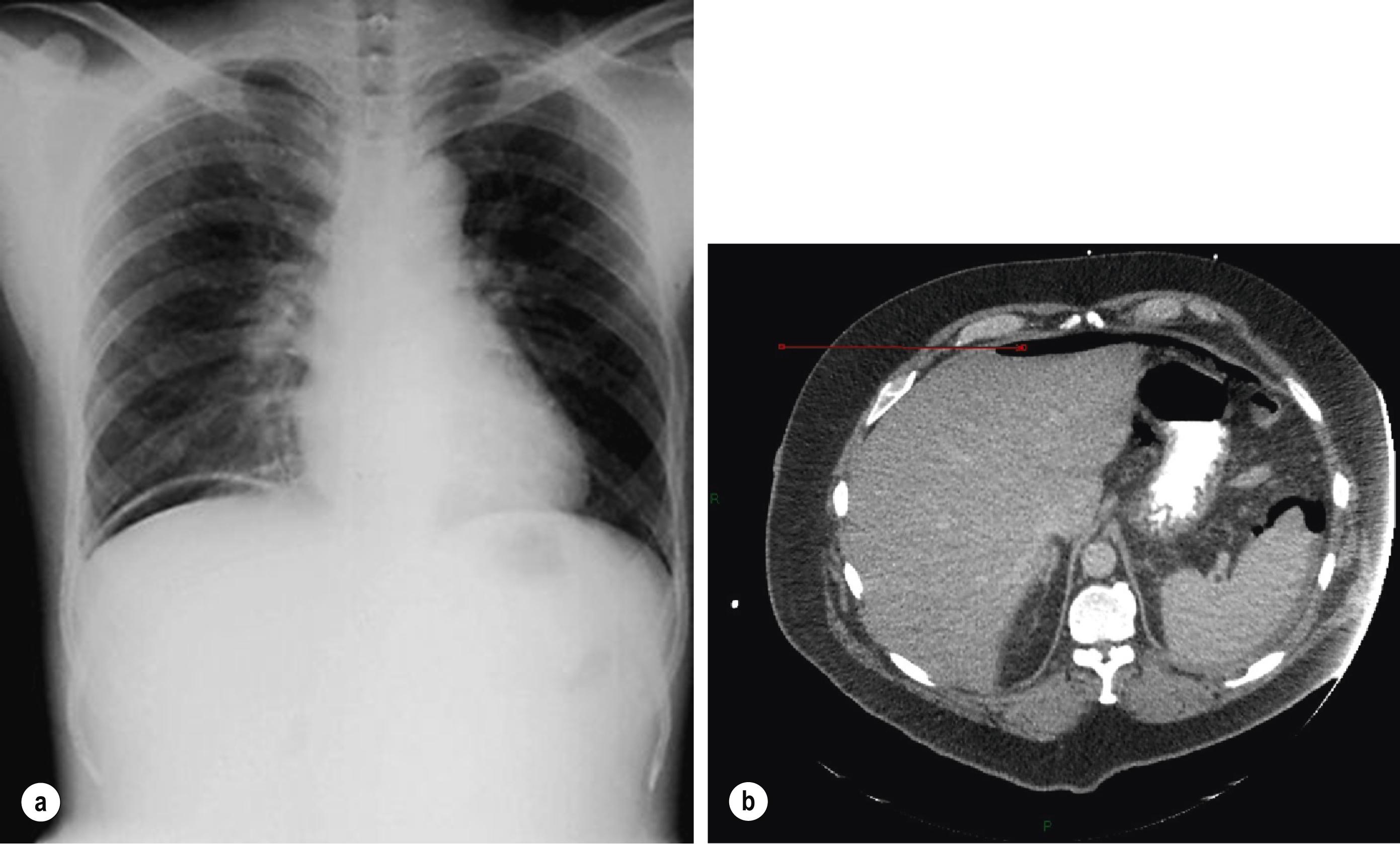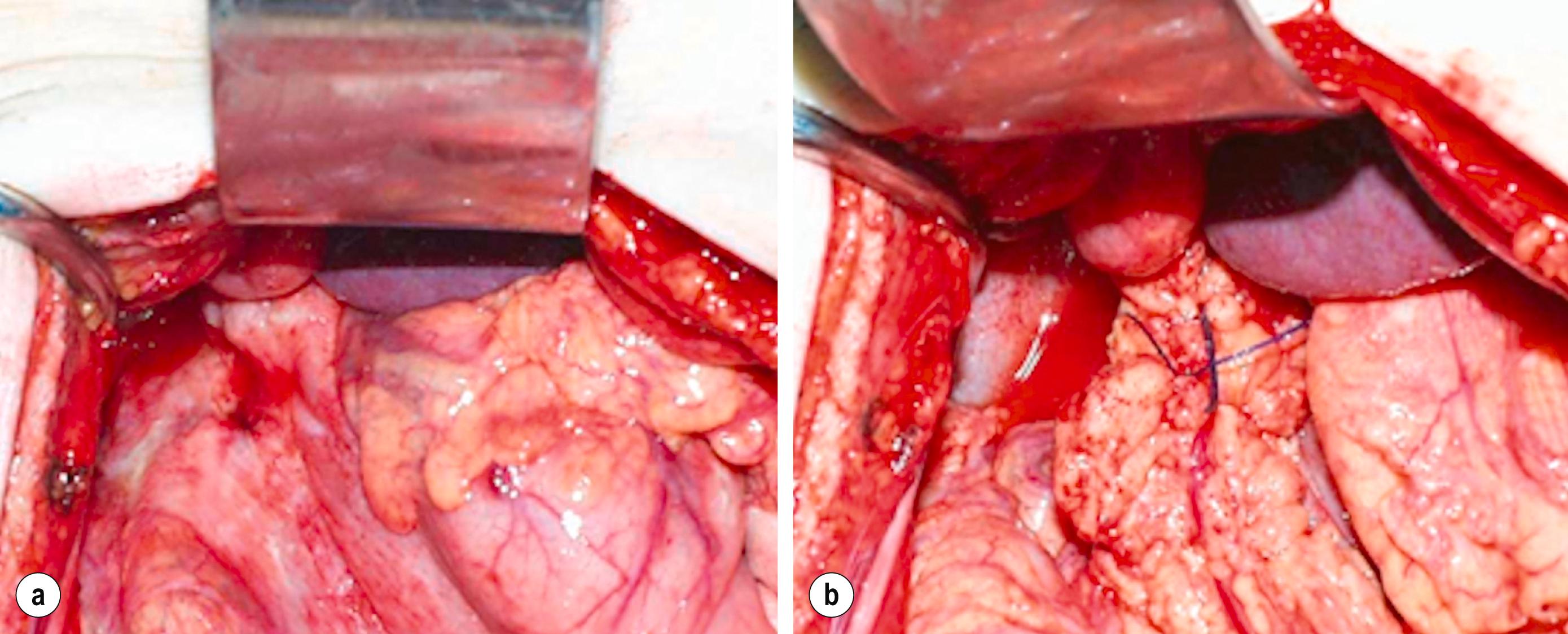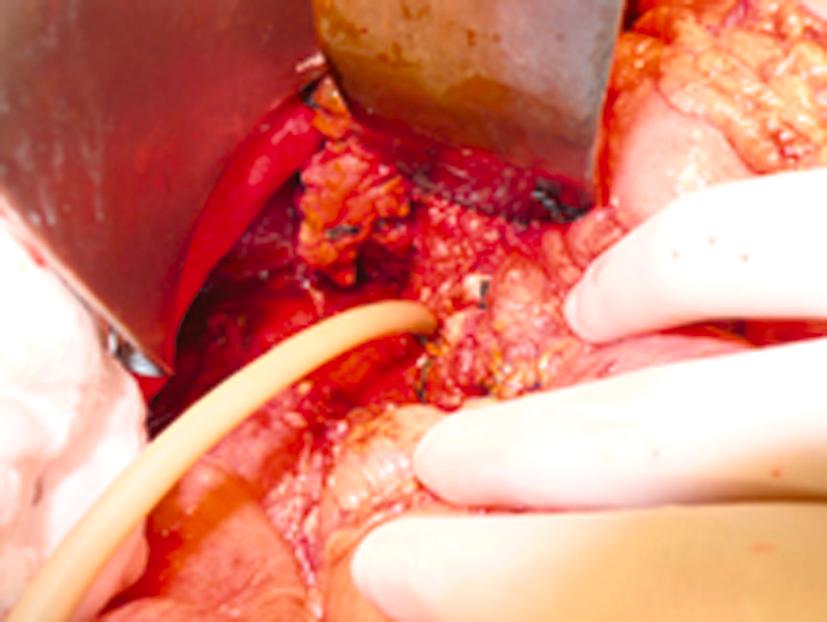Physical Address
304 North Cardinal St.
Dorchester Center, MA 02124
Perforation of the upper gastrointestinal (UGI) tract is a relatively common surgical emergency. Most cases are due to peptic ulceration, but other causes, although uncommon, may be challenging to diagnose and manage (e.g. oesophageal perforation). Perforation secondary to endoscopic procedures is also increasingly seen in recent times due to technological advancement and more widespread integration of these techniques into mainstream practice.
Perforation can be free or contained. Free perforation into a body cavity (peritoneal or pleural cavities or the mediastinum) results in gross contamination and the clinical features often correlate with the site, degree and nature of contamination. For example, free intra-abdominal perforation causes generalised abdominal pain and generalised peritonitis. The nature of the leaking contents is determined by the location of the perforation. In the UGI tract, the contamination will be microbial and chemical (e.g. acidic rich fluid from the stomach and bile-rich fluid from the duodenum). Further, the rapidity of symptom development can also correlate with the nature of the contents being leaked (chemical peritonitis results in sudden and severe pain, while the development of infection can take time). Less commonly, the contamination can be contained, such as rapid ‘walling-off’ of an intraperitoneal perforation by the omentum, or a retroperitoneal perforation. This scenario often gives more localised clinical features and frequently results in abscess formation.
A high index of suspicion with appropriate and timely investigation will lead to early diagnosis, which has been shown to reduce length of stay, reduce the need for reintervention and a reduction in mortality. , All general surgeons should be capable of caring for patients with gastroduodenal perforations, but better outcomes are seen with more complex cases, such as oesophageal perforation, when they are cared for in an experienced centre.
This chapter will outline the main principles of management of perforations of the UGI tract, including diagnosis, initial management and surgical techniques, follow-up care, and complications. Areas of controversy will be highlighted and novel techniques will be considered. The specific management of anastomotic leak is covered elsewhere in this book series.
Perforations of the UGI tract affect the oesophagus, stomach or duodenum. The aetiology varies according to site. The causes of UGI tract perforation may be considered according to the relationship with the gastrointestinal tract: intra-luminal, mural or extra-luminal or classified according to underlying pathology ( Table 12.1 ). Perforations may be due to disease (peptic ulcer disease [PUD] or malignancy), iatrogenic (following endoscopy or gastric band erosion), following foreign body ingestion (batteries or caustic liquids), medication-related (non-steroidal anti-inflammatory drugs [NSAIDs]) or spontaneous (Boerhaave’s syndrome). Peptic ulcer perforations occurring in the duodenum and stomach are by far the most common.
| Oesophageal |
|
|
|
|
|
|
|
|
|
| Gastric |
|
|
|
|
|
| Duodenal |
|
|
|
|
|
|
PUD is by far the commonest cause of UGI perforation with an annual incidence of 4–14 per 100 000 individuals. However, the incidence is reducing, presumably related to a better understanding and treatment of Helicobacter pylori and reduced rates of smoking. Approximately 98% of peptic ulcers are located in or around the pylorus with 80% occurring in the first part of the duodenum. Ulcers located elsewhere, especially in the proximal stomach, raise the possibility of malignant aetiology and multiple ulcers may suggest less common conditions such as Zollinger-Ellison syndrome. Peptic ulceration occurs due to an imbalance between the gastroduodenal mucosal protective defences and potentially damaging forces. H. pylori has been identified in 80–90% of patients with duodenal ulceration. H. pylori increases damaging forces by increasing local gastric acid secretion contributing to the pathogenesis of ulcer formation. Drugs, particularly NSAIDs, are associated with 20–30% of peptic ulcers. Smoking and alcohol are also implicated due to the adverse effect on protective mucosal defences.
In general, patients will present with an acute illness. Epigastric pain usually predominates which is often sudden onset. There may be a history of dull epigastric pain in the preceding days or weeks. Diaphragmatic irritation causes pain to radiate to the shoulders. Generalised abdominal pain implies free perforation and generalised peritonitis. Some patients, especially the elderly or immunocompromised, may have surprisingly little pain and few signs. Other features may include nausea, vomiting, history of dyspepsia, or small volume haematemesis. History taking should include a detailed drug history and documentation of comorbidity and a pre-morbid functional assessment. Many patients will appear unwell and exhibit systemic signs and symptoms of sepsis or shock, including fever, sweating, hypotension and clamminess. Abdominal examination will usually reveal generalised guarding due to peritonitis. Vital signs should be assessed and initial supportive measures commenced in a timely and systematic manner.
Differential diagnoses include many conditions that present with an acute abdomen, such as acute pancreatitis, perforated appendicitis and intestinal ischaemia. A plain chest X-ray may demonstrate subphrenic free gas, but this sign is only evident in around 70% of cases ( Fig. 12.1a ). Computed tomography (CT) is the gold standard for the investigation of suspected UGI perforation ( Fig. 12.1b ). The presence of pneumoperitoneum and free fluid is diagnostic and may even help locate the site of perforation. Patterns of pneumoperitoneum may help predict upper versus lower gastrointestinal perforation (e.g. periportal free air is suggestive of UGI perforation) and the location of inflammatory changes and/or wall discontinuity may also be visible on the images. Oral contrast is not routinely used in the initial imaging of the acute abdomen but may be useful in selected cases where the diagnosis remains in doubt or an attempt at non-operative management is appropriate and it is necessary to demonstrate that there is no evidence of ongoing leakage.

Initial management should focus on resuscitation in a systematic process. In some instances, it may be necessary to initiate resuscitative measures at the same time as making the initial clinical assessment. Consideration should be given to involve critical care teams early. Critical care support is indicated in the presence of organ dysfunction, where there is evidence of abnormal physiology (e.g. elevated serum lactate), and where the patient is predicted high risk on relevant scoring systems (e.g. NELA or P-POSSUM risk predictors). Oxygen therapy should be administered, intravenous access achieved and adequate doses of parenteral analgesia should be provided. Intravenous fluids should be prescribed and broad-spectrum antibiotics should be commenced as soon as possible in accordance with the principles of the ‘Sepsis 6’ care bundle. Surgery is the mainstay treatment for most patients with perforated PUD. Patients should proceed to theatre as soon as is practical and following appropriate resuscitation. Delay to surgery is a clear prognostic factor and mortality increases by approximately 2.5% per hour after admission.
![]() Delay to definitive treatment is an important determinant of poor outcome for patients with UGI tract perforation. Delay to surgery is an established adverse prognostic factor with mortality rates increasing for every hour of delay. These findings are equally valid for the management of both peptic perforation and oesophageal perforation. Every effort should be taken to ensure patients are diagnosed, resuscitated and receive definitive treatment in a timely fashion.
Delay to definitive treatment is an important determinant of poor outcome for patients with UGI tract perforation. Delay to surgery is an established adverse prognostic factor with mortality rates increasing for every hour of delay. These findings are equally valid for the management of both peptic perforation and oesophageal perforation. Every effort should be taken to ensure patients are diagnosed, resuscitated and receive definitive treatment in a timely fashion.
Omental patch repair and thorough peritoneal lavage are the principles of surgical management and are sufficient for most patients. The patch is usually a well vascularised omental pedicle but in instances where there is paucity of omentum or it is absent, the falciform ligament may be used. It is the author’s opinion that no attempt should be made to primarily close the ulcer but simply to cover with a viable omental patch ( Fig. 12.2 ). A thorough and extensive peritoneal washout is vital. The value of placing an abdominal drain remains controversial, although there is some evidence that drainage provides no benefit and may indeed be harmful. A drain should therefore be used selectively.

There are several studies including a meta-analysis of randomised controlled trials as well as a large propensity score-matched series favouring minimally invasive surgery over conventional open surgery for selected patients. , These reviews confirm a significant reduction in postoperative morbidity (particularly surgical site infection rates), reduced length of hospital stay and a possible mortality benefit. Indeed, there is now sufficient evidence that laparoscopic repair is the standard of care in centres with appropriate equipment and expertise. However, appropriate patient selection is vital to ensure good outcomes. Limitations of minimally invasive surgery are the requirement for a pneumoperitoneum, difficulty removing large food debris and possibly longer operating times. Therefore, patients who are clinically unstable, the elderly patient and in situations where there is gross peritoneal contamination may be better managed with open surgery. Whatever approach is used, the priority should always be the provision of safe and effective surgery.
![]() There is some evidence that minimally invasive surgery has advantages over open surgery in the management of perforated PUD. Laparoscopic surgery is associated with a reduction in wound complications and length of hospital stay without any difference in leak rate, abscess formation or mortality. However, it is important to emphasise that not all patients are suited to a minimally invasive approach and appropriate patient selection is vital to ensure a good outcome.
There is some evidence that minimally invasive surgery has advantages over open surgery in the management of perforated PUD. Laparoscopic surgery is associated with a reduction in wound complications and length of hospital stay without any difference in leak rate, abscess formation or mortality. However, it is important to emphasise that not all patients are suited to a minimally invasive approach and appropriate patient selection is vital to ensure a good outcome.
Gastric ulcers should always be biopsied as they carry a small risk of malignancy. In some circumstances ulcer excision may be a better option where there is sufficient redundant stomach to allow limited resection of the ulcer to ensure healthy tissue for closure and to maximise the amount of tissue for histological assessment. This remains the preferred approach even in circumstances where there is a high index of suspicion that the gastric perforation is malignant. Retrospective analyses demonstrate increased morbidity and mortality when a gastrectomy is performed rather than a simple repair and urgent rather than elective gastrectomy results in an increased positive surgical margin rate, increased inpatient mortality and decreased overall survival. , Major oncological resections are best done electively after normal physiology is restored, appropriate work-up including staging is completed, and the full range of treatment options has been discussed at a multidisciplinary team meeting (such as considering a role for preoperative chemotherapy). Similar oncological outcomes including overall survival can be achieved for selected patients by adopting this approach when comparing perforated and non-perforated gastric cancers treated with a curative resection, suggesting there is no reason to rush. ,
![]() For perforated gastric ulcers, a simple repair (omental patch or local ulcer excision) is the best management option even when malignancy is suspected. There is no role for attempted cancer resection in this setting.
For perforated gastric ulcers, a simple repair (omental patch or local ulcer excision) is the best management option even when malignancy is suspected. There is no role for attempted cancer resection in this setting.
However, there are circumstances where a simple omental patch or limited ulcer excision is not possible or is considered likely to fail. This may occur with large duodenal perforations where the defect may be several centimetres and the surrounding tissue may be extremely friable. There are several procedures described to manage this scenario. The simplest procedure is to create a controlled fistula by placing a tube drain or T-tube into the duodenal defect and approximating the surrounding tissue ( Fig. 12.3 ). This creates a definite leak and therefore should probably be reserved for instances where the patient is very unwell and abnormal physiology dictates a simpler and faster approach. It may be a better option to attempt to repair the duodenum, possibly with a double layer repair or an overlying omental patch, and placing adjacent drains. If the repair leaks, then the drains will create a controlled fistula. In some circumstances, it might be appropriate to consider a resection of the ulcer tissue. This would normally involve an antrectomy with Roux-en-Y reconstruction. This procedure carries the advantage of removing the ulcerated tissue and allowing earlier introduction of enteral nutrition. However, managing the duodenal stump remains challenging and this procedure should only be considered in patients with normal physiology. There are many other techniques described to manage this challenging scenario including a Finney pyloroplasty and creating a duodenojejunostomy. Many of these procedures are now considered historical. Selecting the best approach for an individual patient is the key to maximising chances of a favourable outcome.

Non-operative management of peptic ulcer perforation may be appropriate for selected patients. Patients who are clinically well, with normal physiology and vital signs and without evidence of peritonitis, may be considered suitable for a trial of non-operative management. Cross-sectional imaging with oral contrast is also useful to support a conservative treatment approach. Minimal peritoneal contamination and no leak of oral contrast would favour a successful outcome. Patients should be maintained nil by mouth, have nasogastric drainage, intravenous fluids, intravenous proton pump inhibitors (PPI) and antibiotics. Frequent review by an experienced clinician is mandatory and any deterioration in the condition of the patient should be interpreted as a failure of non-operative management. Up to 70% of patients may avoid surgery by adopting this strategy and with appropriate patient selection, although it is important to note that non-operative management in patients over 70 years old is associated with a poorer outcome. , There is no role for endoscopic management, such as application of clips, in the management of these patients.
Although there are relatively few trials of PPI in relation to UGI perforations including PUD, there is a considerable body of evidence showing a large reduction in bleeding and re-bleeding risk in PUD, and it seems logical that there would be both early and late benefits in relation to perforation. There are data that suggest intermittent dosing is as effective as an infusion and that oral is as effective as intravenous dosing. ,
In the absence of randomised trials, experienced clinical judgement and local practice should guide antimicrobial choice. Antibiotics are generally continued for 7 days and should be administered by the intravenous route until oral intake is established. In most centres, antifungal agents are reserved for high-risk patients (such as immunosuppressed patients) or those with a positive culture and clinically severe infection.
Become a Clinical Tree membership for Full access and enjoy Unlimited articles
If you are a member. Log in here